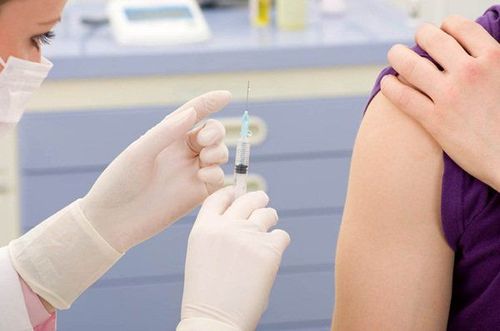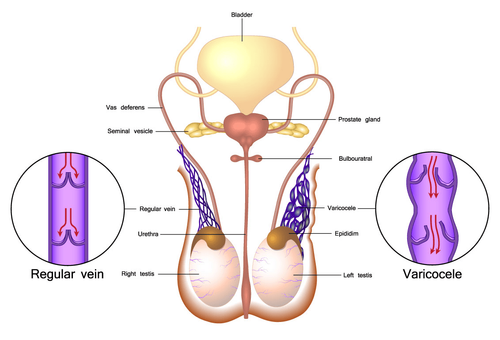This is an automatically translated article.
Conception is a natural process of the body but also very complex and magical. The chances of getting pregnant will vary from person to person. Therefore, building a fertility cycle chart or tracking body parameters helps to make the conception process easier and more effective.
1. Reproductive cycle chart
Fertility cycle charting can help you:
Test to find out the approximate time for ovulation Compare basal body temperature to basal body temperature when you are resting. Check cervical mucus. Track your entire menstrual cycle from start to finish. Thanks to the fertility cycle chart, it will help couples know more information such as when a woman ovulates, or releases an egg or regular sex will improve fertility or the ability to get pregnant. .

Biểu đồ chu kỳ sinh sản giúp các cặp vợ chồng cải thiện khả năng sinh sản bằng cách quan hệ tình dục
2. Tests and tools to predict ovulation for fertility cycle charting
Tests and devices that use ovulation prediction to build fertility cycle charts will provide information for tracking fertility cycles. Everyone will have different usage.
2.1. Ovulation Prediction Kits (OPKs)
You can buy this kit at most drugstores. It works to test the amount of Luteinizing hormone (LH) in the urine of women.
The OPK kit can alert you to an increase in LH levels that occurs 12 to 36 hours before ovulation. Studies also show that this toolkit is more than 90% accurate. Moreover, the OPK kit is used on a digital basis, it will be added with a screen to make it easier to read the results after conducting the test.

Bộ dụng cụ dự đoán rụng trứng (OPKs) giúp kiểm tra lượng hormone Luteinizing (LH)
2.2. Progesterone Ovulation Test
You can find this test kit at drugstores. It is used to test the concentration of the metabolite progesterone in the urine of women for several days. Metabolite concentrations usually increase 24 to 36 hours after ovulation. Therefore, finding the metabolite progesterone in your urine could signify that you are ovulating.
2.3. Saliva microscopy or fermentation
These are small microscopes. Sometimes designed to look like a lipstick case. It has the effect of testing saliva samples. As estrogen levels build up, ovulation begins and salt levels in saliva increase as well.
This saliva will be examined under a microscope and the results show that the salt will create a pattern resembling the leaves of a fern. The manufacturer claims that this method can allow you to predict ovulation after 24 to 72 hours. However, some studies have not found this test reliable. Because some results are not clearly interpreted.

Kính hiển vi có thể được sử dụng nhằm dự đoán ngày rụng trứng sau 24 đến 72 giờ
2.4. spawn screen
This type of tool may cost more. But they are quite convenient. While most ovulation predictors and tests, this one only provides the time of ovulation for about 2 days. However, fertility can be up to 6 or 7 days per cycle.
The spawn screen works in different ways.
Clearblue fertility monitor measures the concentration of the hormone LH as well as other hormones and the e3G component in the urine. The results are easy to understand and displayed on the digital display. They are also stored in the display's memory. Studies show that this measuring tool is more than 90% accurate. The functional OvaCue fertility monitor checks the level of electrolytes in the saliva. This method is easy to use (you just need to put a sensor in your mouth), stores data and shows clear results. This device's vaginal sensor can be used to confirm ovulation. But a few studies give mixed results on how effective this approach is. While all of these tests and devices can be helpful, remember that they're not perfect. If you have certain health problems such as polycystic ovary syndrome (PCOS) or take medications, they may not give accurate results.
3. Body temperature helps monitor fertility
Checking basal body temperature is a way of predicting ovulation and it is also good information that makes it easier for women to get pregnant. However, recent studies have shown that it may not work exactly as experts once hypothesized.
Before ovulation, basal body temperature usually fluctuates between 36 and 35.4 degrees Celsius, although this number will not be the same for everyone.
During ovulation, the body releases the hormone progesterone, which causes the body's temperature to rise slightly a day or two later, usually 0.5 degrees. Your body temperature will likely stay high until the next cycle begins. If you get pregnant during that cycle, your temperature will be over the top. Half of this difference may not seem like much, but it's worth it. Also, keep in mind that body temperature swings happen after ovulation, which means that once it rises, you've probably missed your chance of getting pregnant during that cycle. But by charting your basal body temperature each day over multiple cycles, you can begin to see a pattern that allows you to predict when you're most fertile. Some tips for taking and understanding basal temperature This can be as follows:
Start taking your body temperature on the first day of your period. You will need a thermometer that measures one tenth of a degree.

Đo nhiệt độ cơ thể cho phép dự đoán khoảng thời gian rụng trứng
Make sure you take it at the same time every day, preferably before you get out of bed in the morning. Don't do anything like: eat, drink, smoke or even move before you raise your temperature. You can take your body temperature however you want, such as: by mouth, rectally, or vaginally, but make sure you use the same technique each time. Write the temperature of each day on the fertility chart. You can create a graph, with each day of your cycle at the bottom and temperature on the left, connecting the dots. After a few months, you may start to see a pattern showing when you normally ovulate. You can then ask your doctor to help you interpret the chart you've built.
Although the chart is widely used, it cannot be 100% accurate. Because in some women, they may not be able to find a clear pattern in body temperature. Because ovulation can happen at different times in your cycle from month to month, the chart may not predict when you'll ovulate.
4. Endometrial lining and ovulation
Although it can be time-consuming and can be uncomfortable for some people, knowing how to detect changes in cervical mucus can be an easy and effective way to predict ovulation period. Some studies show that the endometrial test is more accurate than basal basal body temperature charts, although you can also use both methods at the same time.
How it works: The mucus secreted by the cervix, the tissue of the tissue connecting the vagina and the uterus will have different roles. When you don't ovulate or are about to ovulate, cervical mucus prevents sperm from entering your uterus, so you can't get pregnant. As you near ovulation, the cervix secretes more mucus. When you are most fertile, your cervical mucus will be tight and clear, like egg whites. At this point, the uterine mucus will protect the sperm and help them in their journey towards the egg.

Chất nhầy gần giống lòng trắng trứng gà báo hiệu sắp tới ngày rụng trứng
Days 1-5: Menstruation occurs. Days 6-9: Vaginal dryness with little or no mucus. Days 10-12: Mucus, sticky appearing, gradually becomes less thick and whiter. Days 13-15: The mucus becomes thin, slippery, stretchy, and looks like egg whites. This is the most fertile period. Days 16-21: Mucus becomes sticky and thick again. Days 22-28: The vagina becomes dry. But each person's cycle can be very different from this pattern, which is why it's so helpful to mark changes on your fertility chart. Ideally, you should check your cervical mucus every day, possibly every time you go to the bathroom. If you rub some toilet paper or your finger through the vaginal opening, you should be able to find cervical mucus. Check the color and consistency between the fingers and record the changes if any.
5. Cervical position and ovulation
Another way to learn about the fertility cycle is to check the position of the cervix. If you put two fingers into the vagina, you should feel the cervix at the end. Before you ovulate, it will be hard and dry, like the tip of your nose.
During ovulation you should notice that the position of the cervix seems to have shifted higher and it is softer and wetter. But you should always make sure that your hands are clean before you start testing.
Please dial HOTLINE for more information or register for an appointment HERE. Download MyVinmec app to make appointments faster and to manage your bookings easily.
Reference source: webmd.com













